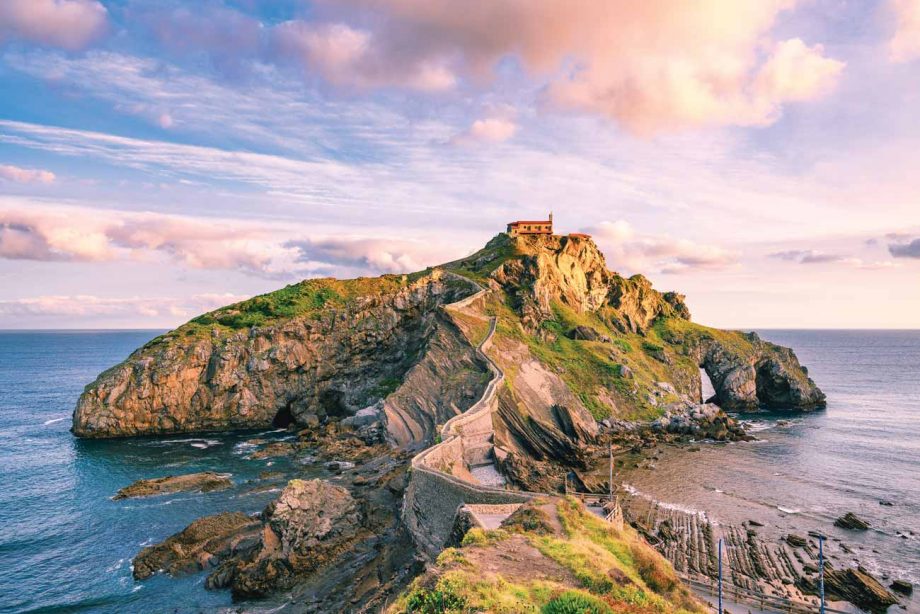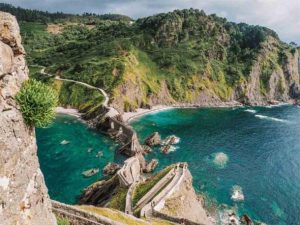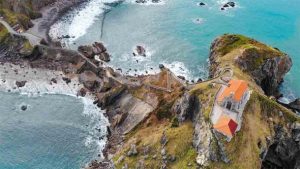San Juan de Gaztelugatxe: Visit the Basque Dragonstone on a Pilgrimage

Overlooking the Atlantic waters of the Bay of Biscay, the 1,000-year-old hermitage of San Juan de Gaztelugatxe is a magical place to visit in the Basque Country. Surrounded by striking cliffs, this itty-bitty islet can be found just 35 km (22 mi) to the east of Bilbao.
Gaztelugatxe, meaning “castle rock” in Basque, is not an easy place to visit. After hiking through breathtaking scenery, visitors have to traverse a double-arched stone bridge before climbing the 241 steps of a winding staircase up to a small shrine dedicated to Saint John the Baptist. Once there, the views of the surrounding area are stunning.

View down the 241 steps at the islet of San Juan de Gaztelugatxe. (KseniaJoyg / Adobe Stock)
The Eventful Story of San Juan de Gaztelugatxe
As with the entire coastline in the area, the islet itself has been created by the tireless Atlantic eroding the coastline to form tunnels, cliffs and arches of all shapes and sizes. Joined to the mainland by a stone bridge, San Juan de Gaztelugatxe rises up 150 meters (492 ft) above the sea offering a strategic view, an advantage that has ensured the island become the backdrop to certain key historic moments.
According to the Euskadi Basque Country official tourism website, the hermitage of San Juan de Gaztelugatxe ( la Ermita de San Juan de Gaztelugatxe), was first built back in the 9th century. It was later donated to the San Juan de la Peña monastery by the Lord of Biscay in the 11th century and became a convent the following century. Unfortunately, the small shrine at the top is not the original, as the island has seen its fair share of action and misfortune.
The rock island and its chapel have not only served a religious purpose, but a defensive function as well, in that San Juan de Gaztelugatxe was strategically located to help protect the Lord of Biscay in his struggles against the King of Castile. In 1334, the Lord of Biscay, at the time Juan Núñez de Lara, was chased to the islet by Alfonso XI the King of Castile and held out for over a month.
Folk tales claim that at different moments in history it has been the scene of numerous battles, attacked by pirates, pillaged innumerable times and has even been a witches’ coven. In 1593 San Juan de Gaztelugatxe was famously attacked by the infamous Sir Francis Drake, while it was assaulted again by the English in the 18th century.
In March 1937, the unique formation bore witness to the naval battle of Cape Machichaco, between the Spanish Nationalists and the Basque Navy who was aiding a Republican convoy during the Spanish Civil War.
In 1978 it was destroyed by a fire, before being rebuilt and reopened in the 1980s.

Aerial view of the hermitage at San Juan de Gaztelugatxe. (Clementp.fr / CC BY-SA 4.0)
Legends of Good Fortune at San Juan de Gaztelugatxe
San Juan de Gaztelugatxe is a popular pilgrimage destination. According to folk tradition, John the Baptist, after whom it has been named, visited the islet, leaving his footprint on the final step. You can still step in this footprint today in the hope of receiving good fortune. A tried and tested strategy for attracting attention throughout the ages, this story transformed Gaztelugatxe into one of the most important pilgrimage destinations along the Basque coast.
This is particularly true during the San Juan festivities which take place on 24 June every year, and for which devotees visit to give thanks to the popular saint. Viajes explains that locals also “leave flower offerings to an image of the Virgin which was installed at the bottom of the sea in 1963.” Gaztelugatxe is synonymous with fishermen, with the interior of the shrine brimming with votive offerings left behind by sailors in thanks for being rescued from the mighty waters of the sea.
Legend has it that on reaching the belfry, after scaling the seemingly endless steps that lead up to the shrine, ringing the bell three times will bring luck to the bell ringer, ward off the evil eye or even grant you a wish. True or not, it’s a hit with pilgrims and tourists alike. While remaining a quaint tradition, “multiply these three rings by several hundred a day, as tourists stand in line for the pleasure, and the result is enough to test the most patient of the gods,” highlights Pedro Gorospe in El Pais.

The use of San Juan de Gaztelugatxe as a location for filming season seven of Game of Thrones increased tourism to the area. (mimadeo / Adobe Stock)
Visiting Gaztelugatxe
Just a 45-minute drive from Bilbao, the shrine is about a one-hour hike from Bakio. Visitors need to book their visit beforehand, a scheme which was created to avoid swamping the shrine with too many guests. You should wear comfortable shoes and sensible clothing, use sunscreen and bring water. The pathway and stairs are steep, and are not recommended for anyone with reduced mobility or health problems. The site is open from 11 am to 6 pm all year, but you should arrive as early as you can to avoid the hordes.